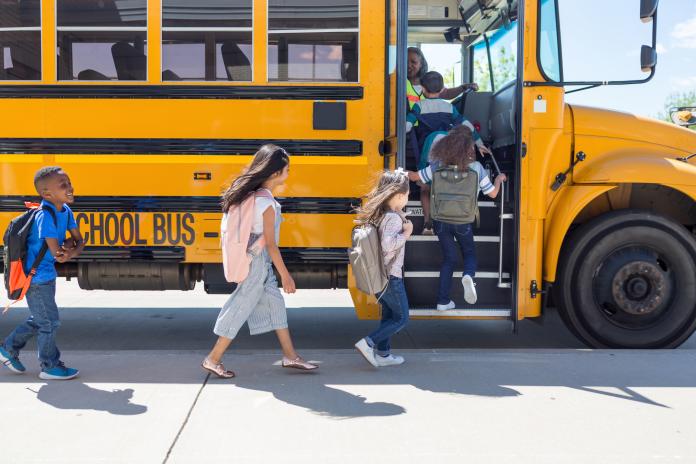Step-by-Step Guide for School Bus Electrification
Your detailed guide to the things to know, steps to take, stakeholders to consult, and questions to ask for a successful and equitable transition to electric school buses.

This Step-by-Step Guide for School Bus Electrification identifies common steps for electrifying your school bus fleet and how to center equity in that process. School district staff can use this guide to orient themselves and other district stakeholders on the process of planning for and deploying electric school buses and to identify resources for each step along the way.
The transition to electric school buses typically follows a general roadmap and can take around two years of planning before the first buses hit the road with full fleet transition spanning additional years depending upon the size of the fleet and the pace of the transition.
Exact timing and steps will depend upon bus ownership, local capacity, internal processes, financing and funding, facility upgrade needs, local grid capacity and the availability of buses and chargers.
The roadmap steps may run in parallel or be reordered based upon your school district’s priorities, goals, operations and needs. School districts should use these steps as a starting point and then modify as needed to meet local needs.

Please see the School Bus Electrification Template Roadmap, designed to be used in coordination with this step-by-step guide.
Each step of this guide presents opportunities to center equity in the process and outcomes. This equity-oriented approach is critical to ensure that the transition to electric school buses helps address, rather than reinforce, long-standing inequities in our transportation and education systems.
Additionally, school districts should engage the full range of impacted stakeholders from the very beginning of the project to co-develop a roadmap with defined equity strategies.
Throughout the planning stages, school districts can integrate equity considerations when choosing which facilities to upgrade and routes to electrify, ensuring the benefits of this new technology go to the communities that need them most. During procurement, school districts can expand the impact of tax dollars by selecting vendors based on environmental and equity criteria and including community benefits like workforce development into contracts.
Finally, school districts should identify desired measurable outcomes and community benefits — for example, improved air quality and a reduction in greenhouse gas emissions — and then track and communicate progress.
This guide is designed from the perspective of a school district that owns and operates their bus fleet, but many steps will be the same for a district that contracts for bus service. Electrification introduces new roles and responsibilities that can be assigned to existing or new partners, depending on the business model schools select. If a school district contracts out for transportation services, the contractor will likely be responsible for many of the steps provided in this guide.
No matter the ownership and operations approach taken, it is important for school districts to understand their electrification needs and goals to make informed contracting decisions.
Methodology and Resource Selection:
This guide is designed to be a user-friendly resource to help school district staff find information to electrify their school bus fleets and center equity in this process. The Electric School Bus Initiative team looks forward to refining this content in partnership with school districts and other electric school bus stakeholders. Have an idea for how we can improve this guide? Reach out to our team at ESBinfo@wri.org.
The steps identified in the guide were originally developed based upon WRI’s on-the-ground experience with transit fleet electrification in Colombia, Mexico and through the TUMI E-Bus Mission. The process has since been refined through real-world experiences with more than 300 school districts across the United States transitioning their fleet to electric from 2021 to 2025. The guide was informed further by existing resources from WRI’s Electric School Bus Initiative, including the Electric School Bus U.S. Market Study and Buyer’s Guide, Power Planner, Working with Your Utility to Electrify Your School Bus Fleet, Electric School Bus Facility Assessment Guide, and Next Stop: Access!.
The resources referenced throughout this guide were selected based upon a set of criteria that includes organizational credibility and experience of the author, timeliness, relevance for a school district audience and review process of the resource (e.g., presence of a peer review process and/or consultation with school districts during the development of the resource.)
The Electric School Bus Initiative team is testing this guide and associated resources through technical assistance and education provided to school districts across the United States. We will incorporate feedback and lessons learned from this support into future updates of this guide.
We welcome comments and suggestions for how to improve this resource. Please email ESBinfo@wri.org with your suggestions or to schedule a time to chat about ways to improve this website.